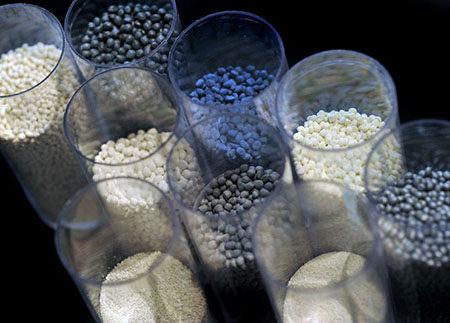Home | Regulations & Compliance | Classification
Classification
IARC
In 1989, the International Agency for Research on Cancer (IARC) concluded that Diantimony Trioxide is possibly carcinogenic to humans (Group 2B), and Antimony Trisulfide is not classifiable with regards to its carcinogenicity to humans (Group 3).
In 2019, Diantimony Trioxide was selected by IARC as a medium priority substance in their 2020-2024 Monographs program. This is most probably aimed at evaluating the results of the US NTP carcinogenicity studies published in 2017.
Globally Harmonized System (GHS) & EU CLP Regulation
i2a has determined the applicable classification for 10 Antimony substances following the UN Globally Harmonized System (GHS) criteria. The classifications reported by i2a take account of the mandatory classifications (e.g. those listed in Annex VI of the CLP Regulation (1272/2008/EC)), the purity profile and physical form of each substance, and all evidence considered to be both relevant and reliable. Read-across and weight of evidence is furthermore applied to predict the properties of those forms of Antimony which have had fewer studies carried out on them.
The resulting ‘self-classifications’ (Table 1 below) are reported in the REACH dossiers, recommended to the value chain, and reviewed whenever necessary (e.g. when new evidence becomes available, for example following an evaluation process).
Table 1. Recommended classifications as per available evidence in May 2019
| Recommended classification and labeling | |||||
|---|---|---|---|---|---|
| CAS Number | Name | Phys-chem | Human health | Environment | Transport |
| 7440-36-0 | Antimony Metal | Not Classified | Not hazardous | Not Classified | Not Dangerous |
| 7440-36-0 | Antimony Metal Powder | Not Classified | Carc. 2, H351 STOT Rep. Exp. 2, H373 | Not Classified | UN No: 2871 Class: 6.1 |
| 1309-64-4 | Diantimony Trioxide | Not Classified | Carc. 2, H351 STOT Rep. Exp. 2, H373 | Not Classified | Not Dangerous |
| 13145-04-6 | Diantimony Trisulfide | Not Classified | Carc. 2, H351 STOT Rep. Exp. 2, H373 | Not Classified | Not Dangerous |
| 1314-60-9 | Antimony Trichloride | Not Classified | Skin Corr. 1B, H314, STOT SE 3 H335 if C ≥ 5% | Aquatic Chronic 2, H411 | UN No: 1733, Class 8, Corrosive |
| 29736-75-2 | Antimony Tris (ethylene glycolate) | Not Classified | Acute Tox. 4, H302, H332 | Aquatic Chronic 2, H411 | UN No: 3077, Class: 9 |
| 1314-60-9 | Antimony Pentoxide | No Classified | Not Classified | Not Classified | Not Dangerous |
| 7647-18-9 | Antimony Pentachloride | Oxid. Liquid 2, H272 | Skin Corr. 1B, H314 | Aquatic Chronic 2, H411 | UN No: 1730, Class 8, Corrosive |
| 15432-85-6 | Sodium Antimonate (A) | Not Classified | Acute Tox. 4, H302, H332 | Aquatic Chronic 2, H411 | UN No: 3077, Class: 9 |
| 33908-66-6 | Sodium Hexahydroxoantimonate | Not Classified | Acute Tox. 4, H302, H332 | Aquatic Chronic 2, H411 | UN No: 3077, Class: 9 |
| 12208-13-8 | Potassium Hexahydroxoantimonate | Not Classified | Acute Tox. 4, H302, H332 | Aquatic Chronic 2, H411 | UN No: 3077, Class: 9 |
It is i2a’s view that the results of the US NTP Carcinogenicity studies published in 2017 do not change the above ‘self-classifications’.
US NTP Report on Carcinogens
In December 2017 the US National Toxicology Program (US NTP) published its final report of the inhalation toxicology and carcinogenesis studies on Antimony trioxide.
According to the US NTP, under the conditions of these 2-year inhalation studies, there was some evidence of carcinogenic activity of Antimony trioxide in rats and clear evidence of carcinogenic activity of Antimony trioxide in mice. These studies have triggered the (re-)evaluation of existing risk assessments and classifications of Antimony trioxide and other Antimony substances.
In 2018 the US NTP published its revised draft Report on Carcinogens (RoC) Monograph on Antimony trioxide. In this monograph, it concludes that Antimony trioxide can reasonably be expected to be a human carcinogen based on sufficient evidence of carcinogenicity from studies in experimental animals and supporting data from mechanistic studies. It hence recommends the listing of Antimony trioxide on the RoC.
It is i2a’s opinion that the US NTP studies mainly confirm that the inhalation of high quantities of very fine particles of Antimony able to reach the deep lung may trigger a number of inflammatory responses. These exposure conditions and the type of response observed in test animals, however, are not representative of realistic human exposure and response to exposure.
Noting that the aim of chemicals classification is to inform and protect humans, none of the results of the US NTP studies indicate that the current ‘self-classification’ would be insufficiently informative or protective. In i2a’s view, the NTP assessment concentrated on the NTP studies and disregarded the equivocal and likely human irrelevance of most evidence when performing its assessment. The listing of Antimony trioxide on the RoC will not send the right signal or provide the right level of information to the producers and users of Antimony trioxide.
ATSDR
In October 2019, the United States Agency for Toxic Substances and Disease Registry (ATSDR) released a new Toxicological Profile for Antimony and Antimony Compounds. The Profile is impressive from the standpoint of the encyclopedic citation of scientific studies dating back 60 or more years. Unfortunately, the breadth of the literature reviewed is not matched by a critical evaluation of toxicological data, as described in the following set of observations.

© AMG Antimony
